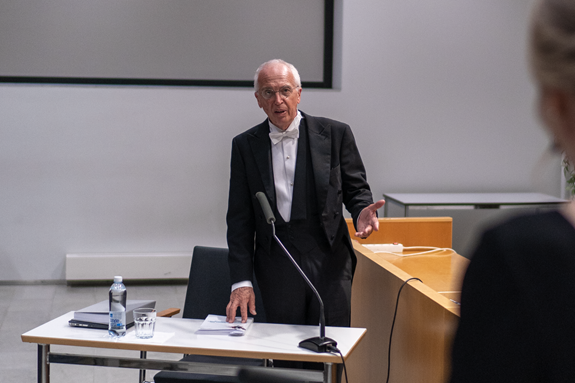The diabetes epidemic is a global health emergency and one of the fastest-growing disease burdens of the 21st century. Medical doctor Fanny Jansson Sigfrids’ dissertation offers novel insights into one of its most serious long-term complications – diabetic kidney disease.
Diabetes remains a serious disease despite improvements in available treatment over the past decades. But why is diabetes so dreaded? Firstly, diabetes is common. Worldwide, 1 in 10 adults have diabetes, and almost half a million Finns are living with a diabetes diagnosis. Moreover, Finland has the questionable honor of having the highest incidence of type 1 diabetes in the world, the disease thus affecting Finns in a greater extent than any other population. Type 1 diabetes accounts for 5-10% of all cases of diabetes, but the more common diabetes subtype, type 2 diabetes, is prevalent here too. Secondly, its acute complications – both too high or too low blood glucose – might be fatal if not treated in a timely manner, and its long-term complications are both common and severe.
Why is diabetic kidney disease important? The reason is that diabetic kidney disease is common, and the consequences are grim.
The long-term complications can be divided into macro- and microvascular complications depending on the sizes of the blood vessels they affect. The macrovascular complications affect the heart, the brain, or the peripheral arteries in the legs. The microvascular complications – diabetic kidney disease, diabetic retinopathy, and diabetic neuropathy – attack smaller blood vessels in the body.
At the Folkhälsan Research Center, the FinnDiane (Finnish Diabetic Nephropathy) Study group studies type 1 diabetes and its complications. For them, diabetic kidney disease is of special interest. The study was founded 25 years ago by Professor Per-Henrik Groop, who has been working with diabetic kidney disease for a significant part of his career.
– Why is diabetic kidney disease important? The reason is that diabetic kidney disease is common, and the consequences are grim, says Groop.
Diabetic kidney disease drives mortality particularly through cardiovascular causes of death. The premature mortality risk increases by a magnitude of three already at the first stage of albuminuria, as compared to the background population without diabetes.

Professor Per-Henrik Groop.
Albuminuria is an indicator of kidney disease and means abnormally high leakage of albumin, a protein normally found in the blood, into the urine. A healthy kidney does not let significant amounts of albumin pass from the blood into the urine. A damaged kidney, however, may let through measurable quantities. The less albumin in your urine, the better. Thus, we can use urinary albumin to measure kidney health, as well as the progression and regression of kidney disease.
– If you go out and screen for urinary albumin or a reduced kidney function, more than every second patient with type 2 diabetes will have signs of kidney disease. In type 1 diabetes, the corresponding proportion is one in three, Groop explains.
Fanny Jansson Sigfrids, medical doctor and researcher at the Folkhälsan Research Center, studied trends of diabetic kidney disease in her recently published doctoral dissertation. The dissertation presents new insights into the incidence, progression, and regression of this microvascular complication of diabetes.
The knowledge on the incidence of diabetic kidney disease, particularly its first albuminuria stages, have been surprisingly limited – both regarding Finland and from an international point of view. My doctoral thesis was designed to fill this gap in the knowledge
– The first clinical sign of diabetic kidney disease is termed moderate albuminuria. At this stage, only very small amounts of albumin in the urine can be detected. However, moderate albuminuria may progress to severe albuminuria and, unfortunately in some individuals, further to kidney failure, explains Jansson Sigfrids.
– The knowledge on the incidence of diabetic kidney disease, particularly its first albuminuria stages, have been surprisingly limited – both regarding Finland and from an international point of view. My doctoral thesis was designed to fill this gap in the knowledge, says Jansson Sigfrids.
To study the incidence of albuminuria, Jansson Sigfrids used a population-based study design encompassing a random sample of 1500 individuals diagnosed with type 1 diabetes between 1970 and 1999 in Finland. She systematically reviewed their medical records to assess the development of kidney disease.

From the left: Professor Per-Henrik Groop, Doctor Fanny Jansson Sigfrids, and Professor Stefano Del Prato, just after Jansson Sigfrids' successful doctoral defense.
– Our results for severe albuminuria are initially optimistic: among those diagnosed with type 1 diabetes between 1970 and 1979, 27% had developed severe albuminuria after 25 years of diabetes, but the corresponding proportion was only 12% among those who developed diabetes during the following decade. This means that between the 1970s and the 1980s, the incidence had approximately halved. However, after the 1980s, the declining trend for both moderate and severe albuminuria had unfortunately plateaued, says Jansson Sigfrids.
– Although moderate albuminuria has traditionally been viewed as a fairly “harmless” stage of kidney disease, this thesis presents some alarming results: even in modern times, over half of the individuals will progress to more severe stages within 15 years of a diagnosis of moderate albuminuria, Jansson Sigfrids continues.
The three other studies included in the doctoral thesis comprised the FinnDiane Study cohort. The detailed clinical data, derived from the examination of the FinnDiane participants over the past 25 years, were analyzed together with cardiovascular and mortality data from national registers. The FinnDiane studies of the doctoral thesis assessed the regression of albuminuria – that is, the change to a less advanced stage of kidney disease over time – as well as the progression in relation to lipid parameters, such as remnant cholesterol.
– Even though regression of albuminuria is a frequent phenomenon, and is associated with an overall improved prognosis, a substantial residual burden of diabetic kidney disease remains to be tackled. Our observational analyses found remnant cholesterol to be robustly associated with kidney disease progression, but also with future cardiovascular events and mortality, so this path warrants to be explored more in detail in the future, says Jansson Sigfrids.
Medical doctor Stefano Del Prato is Professor of Endocrinology and Metabolism at the University of Pisa School of Medicine and Chief of the Section of Diabetes, University of Pisa, Italy. Del Prato served as the opponent at Jansson Sigfrids’ doctoral defense.
Jansson Sigfrids’ kind of work is significant and can help many people with diabetes.
– The diabetes care has changed since the discovery of insulin, and insulin has improved the life and the survival of people with type 1 diabetes and diabetes in general. But it has also exposed them to the risk of multiple complications, one of these complications being kidney failure, Del Prato points out.

Professor Stefano Del Prato as opponent at Jansson Sigfrids doctoral defense.
According to Del Prato, Jansson Sigfrids’ thesis is important because it adds to the understanding of risk factors that could help identify people that are at increased risk of developing diabetic kidney disease.
– This allows us to intervene at an earlier time and in a more effective manner. Jansson Sigfrids’ kind of work is significant and can help many people with diabetes. I really think this kind of research can bring us to the next stage in the treatment of diabetes together with new available solutions for improving glycemic control and for reducing the risk of complications. It’s a progressive increase in the knowledge that is going to help us deal with this condition, Del Prato concludes.
Text & Photography: Simon Granroth, Science Communicator
Fanny Jansson Sigfris' dissertation may be read i full text here.
